One of my favorite things to do when I lived in Alaska was to go to Denali National Park. And the high point of any trip was a chance to see Denali, at 20,310 feet above sea level easily the highest mountain peak in North America, up close and personal.
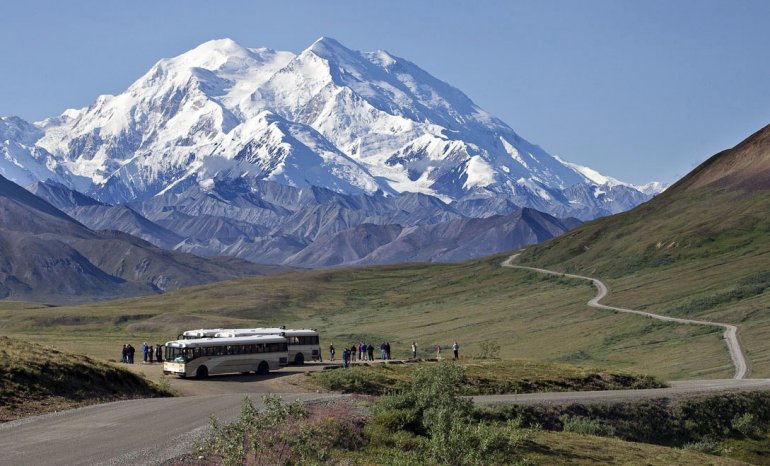
This was the mountain I grew up calling Mount McKinley but back in the 1970s and 1980s when I was there, every Alaskan I knew was already calling the mountain Denali after the Athabaskan name for the mountain which meant “the great one.” The name of the park was officially changed from Mount McKinley National Park to Denali National Park in 1980 and the mountain itself officially renamed Denali in 2015.

As mountains go, by any measure Denali is quite impressive. From Anchorage 135 air miles to the south, on a clear day I could see Denali just popping over the horizon from my 4th floor office in the ARCO Building.
And I remember a few times when I was a student at the University of Alaska at Fairbanks catching spectacular sunset views of Denali 160 air miles to the southwest.

The problem with Denali is that, at over 20,000 feet in elevation, it is usually surrounded by clouds. You simply rarely see Denali’s peak. Alaskans say that Denali makes its own weather and that usually means cloudy all around the mountain’s peak. When you do see the peak, it’s a stunning sight to behold because you just don’t see it that often.

Now there are certainly a lot of things to do and see in Denali National Park besides see Denali. The park is a magnificent piece of pristine Alaskan wilderness. Indeed the park system has gone to great lengths to limit the environmental impact by prohibiting visitors from taking their own vehicles into the park (unless they have a prearranged camping permit for Wonder Lake Campground). Instead visitors get on buses – just like the yellow public school buses I rode when I was kid – that take you as far as 90 miles back into the park along the only road that goes through the park.
I am not sure what things are like today, but when I visited the park back in the 1970s and 1980s, the drivers of these school buses were definitely NOT like those cranky school bus drivers we used to get when we were kids. They were very nice and willing to stop anytime somebody saw wildlife to give everybody a chance to take a look and get photographs. And the wildlife you could see from the bus was amazing.
And what’s more you could get off the bus anywhere you wanted to along the park road, hike around to your heart’s content, and then get back on the next bus that comes by and continue on.
So there were a lot of things to do in Denali National Park. But for most people the high point of the long bus ride into the park was a close-up look at Denali which you actually can’t see in its full glory from its base to its peak until you get some sixty miles into the park. And when you get there, guess what? Denali is almost always covered in clouds! Sorry, no viewing today!
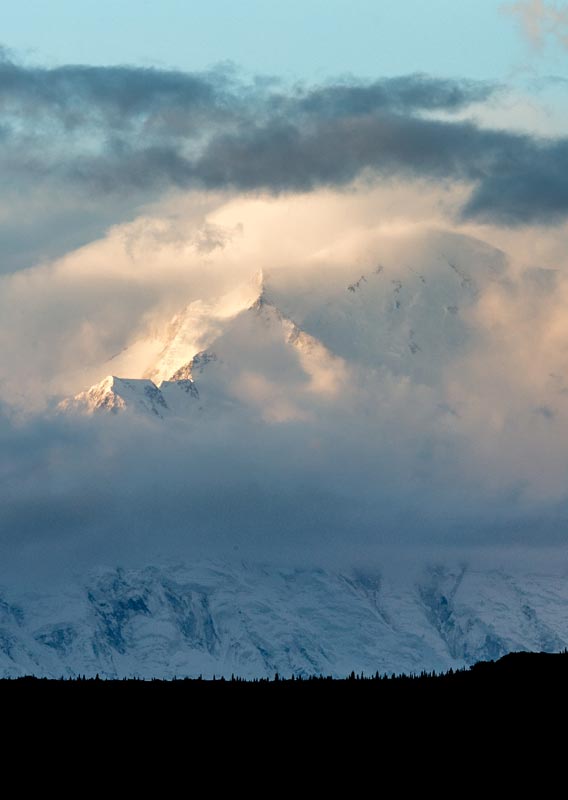
I always felt sorry for all those tourists who would spend so much money to fly to Alaska, take a car or the train to the park, spend half a day taking a bus into the park and never get a chance to really see Denali. In the morning before they got on the bus they could hear from some park ranger that there was no cloud cover but inevitably, by the time they got to Eielson Visitor Center, the clouds had come back with a vengeance.
I had a much better than average experience with Denali because over the course of my dozen or so visits to Denali National Park I found that the best time of year for seeing the peak from inside the park was around Labor Day. By Labor Day most the tourists had long gone but the park was still open. And, I swear, every time I visited the park on the Labor Day weekend, I got a clear view of Denali.

So when I moved to Fairbanks in the fall of 1982 to become a full-time student at the University of Alaska, after getting my stuff moved into my dorm room, seeing as it was Labor Day weekend, I decided I would drive down and spend the weekend in Denali.
I should add that, although I had lots of friends over the years and often went hiking, canoeing, and camping with them, I had been going hiking, canoeing, and camping by myself since I went off to Texas A&M University when I was 17. A lot of people would be afraid to go off and do the kind of things I did by myself but it was second nature to me. I had been doing it for years. As a natural introvert, I loved going off by myself.
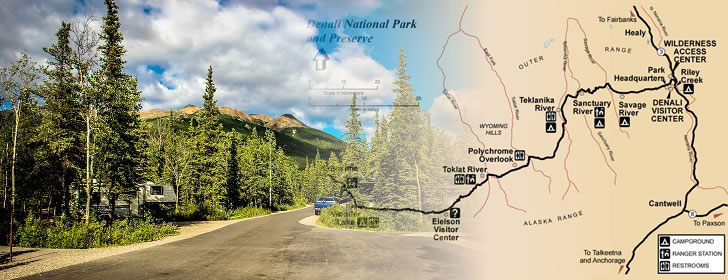
My plan that weekend was to drive down to the park on Friday, spend Friday night at Riley Creek Campground near the entrance of the park. Saturday morning I’d take the bus some way into the park, hike out somewhere and camp. Then Sunday morning hike back to the road, catch a bus, get back in my car and drive back to Fairbanks.

Now the rule at Denali National Park is, if you want to do an overnight hike in the park, you have to go to the Park Headquarters where they issue you a backcountry permit. So when I arrived at the park I went to the office and the ranger there started asking me questions about where I wanted to go.
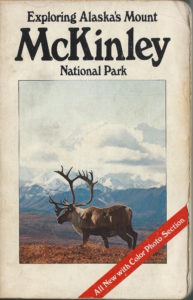
I pulled out my handy guidebook Exploring Alaska’s Mount McKinley National Park. Amazingly, I still have the book. Here it is, the 2nd edition that came out in 1976. Each time I visited the park I would pick out one or more of the book’s recommended hikes to go on.
For this quick little overnighter I chose to do a variation of Hike Seventeen, the Stony Creek Loop.
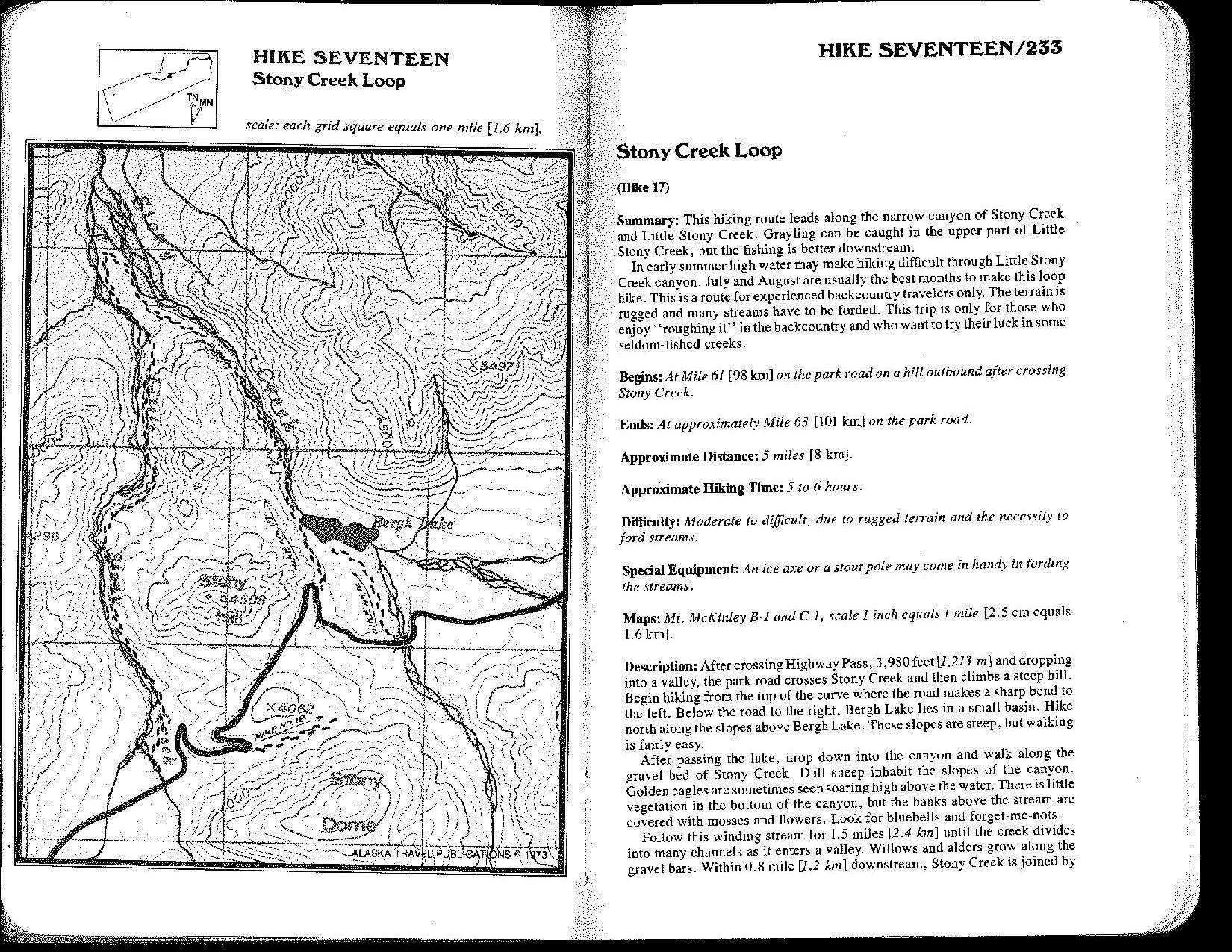
Here’s a detailed map of my route in color.
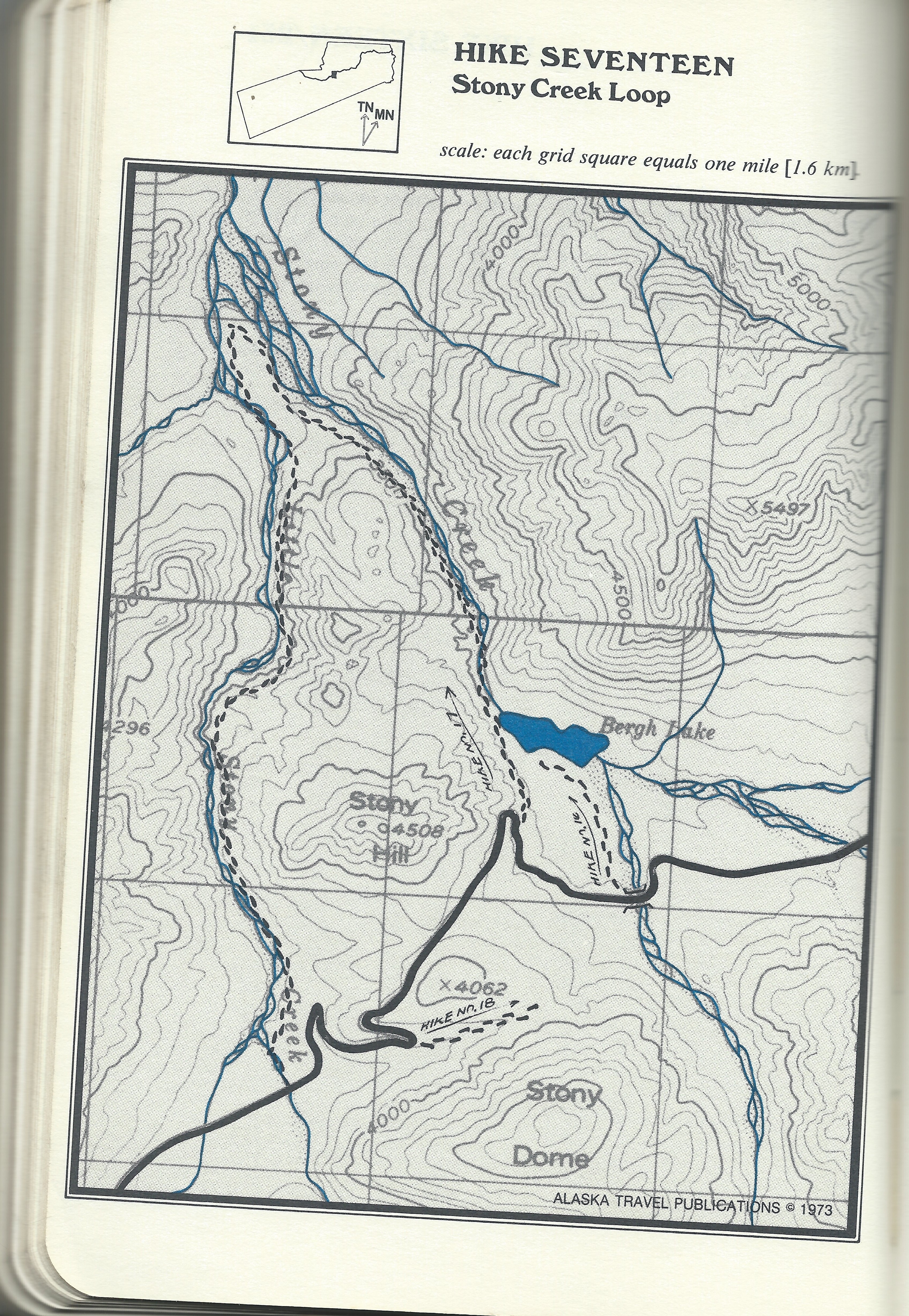
The basic hike was to take the bus to Mile 61 along Park Road, then head north along the slopes of Stony Hill above Bergh Lake until past the lake. Then drop down into the canyon and walk along the gravel bed of Stony Creek a couple of miles to where Little Stony Creek flowed into Stony Creek. Then go up Little Stony Creek to where it crossed the Park Road at Mile 63 where I could catch the bus back. A nice little V route.
I had never hiked this area before but it looked like an easy overnight hike. The ranger agreed it was a nice hike but he said he had to warn me that there had been some grizzly bear sitings in the area so I should be careful.
Now hearing the ranger say there had been some grizzly bear sitings did not faze me in the least. I had seen a couple of grizzly bears while I was camping in Denali before. Admittedly, I was camping with a friend then so I wasn’t alone like I was going to be now. But the grizzlies didn’t seem dangerous. The couple of bears that I had seen were a couple of hundred yards away messing around down by a creek while we were camped up pretty high above the creek. Grizzlies were just one of the many forms of wildlife that flourished in Denali and, indeed, one of the benefits to camping was the chance to see a grizzly because in my dozen or so visits to Denali I had never actually seen one from the bus.
But the ranger wanted to make sure I knew how to avoid having any trouble with grizzlies. And, yes indeed, I knew the rules. Don’t eat or store any food in your tent. Keep all the food in your backpack and keep in a good distance away from your tent. Yes, I knew the rules.
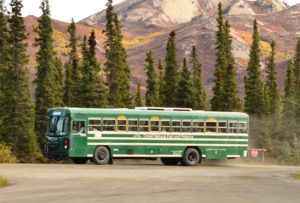 When I woke up Saturday morning, it was one of those typically beautiful Labor Day weekend weather days. My string of success continued!
When I woke up Saturday morning, it was one of those typically beautiful Labor Day weekend weather days. My string of success continued!
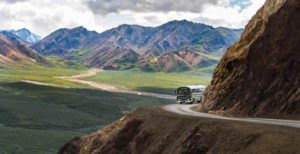
I caught the park bus and took the 3 1/2 hour bus ride out to where my hike began. After getting out of the bus and putting on my backpack, I started hiking north.

I dropped down into a pretty little canyon and then simply started following Stony Creek downstream. Seeing as it was late summer the creek wasn’t very high so it was a nice easy stroll along the gravel bar. The magenta-colored fireweed was in bloom along moist areas of the creek while the banks above the stream were covered with the yellows, reds, and greens that make up the palette of the ground-hugging dry alpine tundra of this part of the park. Overall the first day’s hike was uneventful, very relaxing, with great weather, and no sign of grizzly bears.
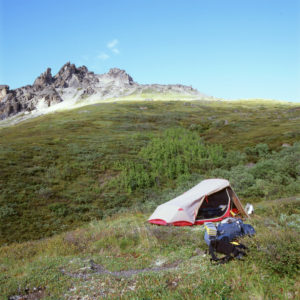 When the creek opened up, rather than continuing down to the confluence of Little Stony Creek with Stony Creek, I decided I would just camp there. I found a nice level spot up above the creek, set up my tent, relaxed a bit, had some dinner, packed up everything nice and tight in my backpack, moved the backpack away from the tent to avoid any problems with grizzly bears, got in the tent and went to sleep.
When the creek opened up, rather than continuing down to the confluence of Little Stony Creek with Stony Creek, I decided I would just camp there. I found a nice level spot up above the creek, set up my tent, relaxed a bit, had some dinner, packed up everything nice and tight in my backpack, moved the backpack away from the tent to avoid any problems with grizzly bears, got in the tent and went to sleep.
The next morning I got up, had a quick breakfast, packed up the tent, and started off on my hike out. But instead of continuing down to where the two creeks came together as I had planned, I decided to simply cross over the slight ridge that divided the two creeks and drop down into Little Stony Creek. That just sounded more interesting to me.
Like practically every hiking route away from the park entrance, there was no particular trail to follow in crossing over the ridge. It was just a matter of hiking in the right direction. The ground was covered with dwarf shrubs, mosses, and grasses that were pretty easy to walk on. When I got to the top of the ridge I could immediately see Little Stony Creek about a 1000 feet away and 200 feet below me and I started heading down to it.

But it wasn’t but about five minutes later when, lo and behold, I saw a grizzly bear bounding down the ridge in front of me, heading toward the creek. The grizzly bear was pretty far away, maybe 500 feet, when I saw it and it never paused in its beeline to the creek. I had no idea what the bear was doing and why it was running so fast. All I knew was the bear was heading right down to the spot in the creek where I had been heading.
I said, whoa! Maybe I won’t head down to the creek just yet. I mean I knew the rules in bear country. The main thing is you don’t want to startle a bear. But down by this creek I could see there were a lot of shrubby willows and alders that sometimes make visibility kind of hard so you have to constantly make a lot of noise to avoid startling a bear.
But the idea of having to make all that noise didn’t appeal to me so, instead of hiking down to the creek right away, I decided I would just continue to hike along the ridge. The ridge was actually more like a flattened plateau with only a slight incline stretching a mile toward Stony Hill with Little Stony Creek on my right. I decided I’d just stay up here for awhile and then drop down to the creek.
Once again it was a beautiful day. I was just feeling very lucky.
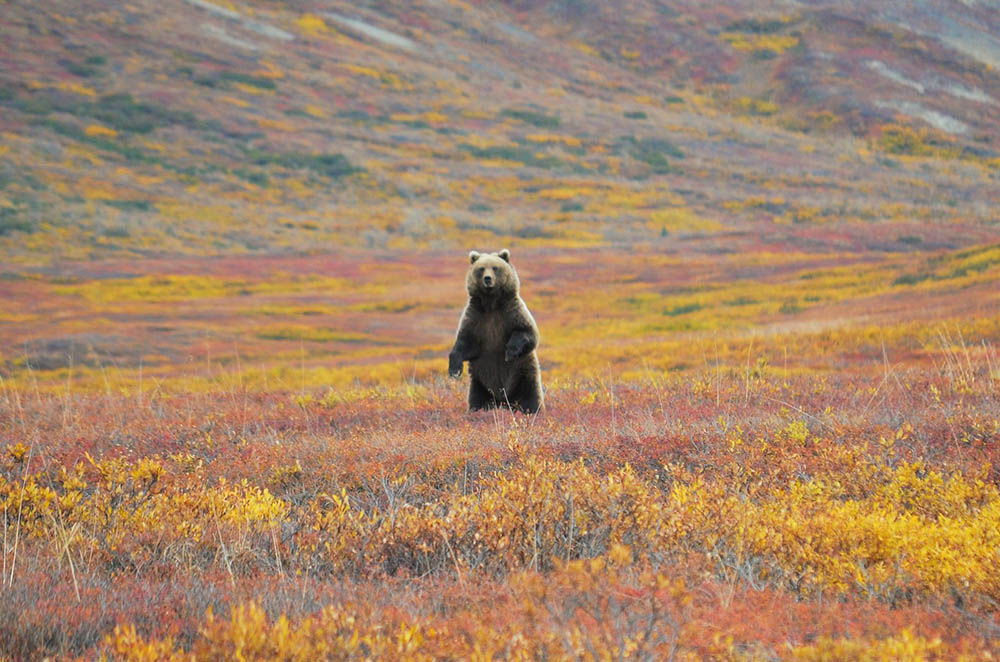
When, damn, it wasn’t but five minutes later, when what did I see but another grizzly, bounding across the flattened ridge in front of me toward the creek, just like the last one. The only difference was that when this grizzly got to right about level with me – the bear froze in its tracks, stood up on its hind legs and looked right at me.
Although the illustrative photos suggest these two bears were about the same distance way, this standing grizzly was actually a lot closer than the previous one. I’d say this grizzly was only like 300 feet away, like a football field away from me. And this one looked pretty big, a full-grown adult male. Grizzlies can get quite big. A full grown adult male grizzly on Kodiak Island can stand as high as ten feet tall. Denali grizzlies don’t get nearly so big, maybe only six feet tall. But I would swear to this day that that grizzly was ten-feet tall.
What I was thinking about was what was I going to do about this ten-foot grizzly staring me down. I quickly tried to recall all the things I was supposed to do and not do in this situation. I remembered that grizzlies have notoriously poor eyesight. I wasn’t sure how poor but I decided I should stand perfectly still. If I didn’t move he might not think I was even alive and then would go on about his business.
The next thing I remembered was that grizzlies have a great sense of smell. So I tried to figure out whether I was upwind of the grizzly (in which case he might smell me) or downwind (in which case he wouldn’t smell me). I couldn’t feel much of a breeze but from what I could sense – without moving an inch – if anything I was downwind of the bear. I let out a very quiet sigh of relief.
While still waiting for the bear to be finished with his interminable staring, I also rehearsed what I was supposed to do if the bear started moving toward me. First things first, running was out of the option. A bear can easily outrun the fastest human which I could easily confirm by the speed with which I saw both these bears bounding across the ridge.
No, what I was supposed to do next was start waving my arms and shouting as loud as I could to let the bear know I was a human. No bear in his right mind would knowing attack a human. Unless, of course, he felt threatened. Or territorial. Or was a mama with cubs. Or wasn’t in his right mind!
If waving and yelling did no good and the bear kept coming at me, maybe even charging – I actually couldn’t remember what to do. Today you are told to use bear spray, but there was no such thing as bear spray back in 1982. So was I supposed to try to punch the bear in the nose like I heard once you should do if a shark attacked you in the ocean? I wasn’t certain but I was pretty sure that might actually be a hard thing to do.
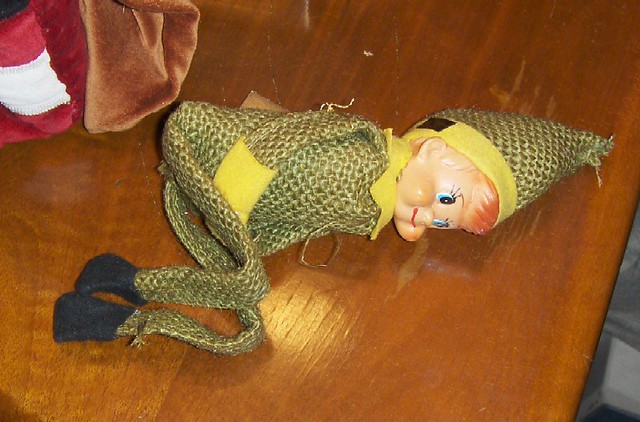
I think what I was supposed to do was keep yelling and screaming until the bear was right on top of you. Then you were supposed to just drop to the ground and curl up in a fetal position with your hands and arms covering your most vital parts. What those vital parts were I wasn’t exactly certain! Then while the bear pawed at you and mauled your body, you were supposed to stay as dead as you possibly could. Even if the bear went away you had to continue to play dead because he could come back. I’m not sure how long you had to play dead before you could start crawling away to safety. Maybe at night time?
All this was going through my head as the bear continued to crane its neck to get a good look or a good whiff of me. I honestly don’t know how long this bear continued his staring act. I suppose it wasn’t any more than 30 seconds but it seemed much longer.
Eventually the bear got tired of staring at me, got down off his hind legs and proceeded on his way, careening down to Little Stony Creek. Again right where I was heading to. Hmmm. Another bear down by the creek. Maybe, I thought, the creek is not such a great place to hike. I knew that eventually I would have to head down to the creek where it cut a canyon at the base on Stony Hill but I decided I should probably try to stay up as high as on this fairly flat ridge as long as I can. At least up here I have good visibility and I can see any grizzlies and they can see me whereas down in the creek valley I’m far more likely to startle a grizzly and that’s the last thing you want to do.
So I continued to hike along the ridge as it continued its gentle ascent toward Stony Hill, aiming toward the point where the creek seemed to come right up to the base of the hill, about half a mile off.
Once again hiking, I remember what a beautiful sunny day it was. My mind was wandering all over the place as it always does when I go hiking. I’m not one to pay attention to all the details like some people do, looking at every little flower or rock. No, I just let my mind wander wherever it wants to go as I take in everything all at once. For all I know I was singing which I am also wont to do when I am off by myself with no one to bug me.
Before you know it I reached the base of Stony Hill and was starting to head around to the right to see if I could find a good way to get down to the creek when I found myself about
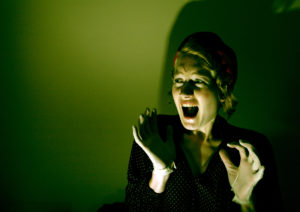
TEN feet away from the rear end of the biggest bear that I had ever seen in my life! And I was frozen with fear.
So how big was this bear?

Well, maybe not as big as this prehistoric South American bear. Actually every time I’ve ever thought about that bear, I remember it as being about the size of a Volkswagen Beetle.
 Have you ever seen a Volkswagen Beetle? My great aunt used to have a Volkswagen Beetle back in the 1960s when I was a kid. In my mind’s eye this bear was the same size as a Volkswagen Beetle.
Have you ever seen a Volkswagen Beetle? My great aunt used to have a Volkswagen Beetle back in the 1960s when I was a kid. In my mind’s eye this bear was the same size as a Volkswagen Beetle.
Now in retrospect no modern grizzly bear is as big as a VW Beetle. And if I had had a camera the photo would in reality have come out looking something like this bear butt. But in my mind’s eye I’ll still sweat that bear was as big as a WV Beetle!

Now you may be wondering how did I actually get that close to a grizzly. Looking back I’m still not certain about that. For my part I know I had not been looking for another bear. Why not? Did I think there wouldn’t be any more bears up on this ridge? What did I think the first two bears were doing up on the ridge in the first place? These bears obviously liked this ridge. So might there have been more than two bears here? Was I living in la la land?
Furthermore I wouldn’t have been able to see the bear from further away. He was down around a bend and down in a little dip, definitely out of my line of sight. (Actually I have no idea what sex this bear was but since this was the biggest bear I had ever seen I assume it was a male.)
But why hadn’t the bear seen, smelled, or heard me? Well I think he would not have seen me because at the moment the bear was facing away from me. And I don’t think he would have heard or smelled me because he was quite busy either eating berries or rooting away at something in the ground. Indeed, the bear was so noisy that I’m surprised I had not heard the bear even if it was around the bend.
Even if the bear had not been making as much noise as he was, he would not have been likely to hear me because I wasn’t making any noise that I know of (unless I was humming or singing). As harrowing as had been the experience of watching the previous bear stare me down for thirty seconds had been, I know I had not been deliberately making noise to announce my imminent arrival like I should have been. I wasn’t trying to be quiet, but I wasn’t trying to warn off any bear. Why not? Shouldn’t I have erred on the side of caution and made noise as I walked just to be on the safe side? Again, for some reason, I just didn’t think there would be any more bears up on the ridge. Then again maybe somehow I did know it was a possibility there was another bear but I thought somehow I could avoid them better by not making noise, as if making noise was more likely to draw them to me rather than avoid me. I don’t know. All I know was that I was staring at the rear end of the biggest grizzly bear I had ever seen in my life. And I was frozen with fear.
I realized that I was in a very dangerous situation. I am pretty certain that if the bear noticed me ten feet away from him he would feel threatened and not just run away. Jumping and shouting at that distance and letting the bear know I am human, I don’t think would work so well. And I never had much faith in the crawling up in a fetal position strategy!
For the time being I was lucky that the bear was facing away from me and was absorbed in eating berries or whatever so he didn’t see, hear or smell me. But I knew I didn’t have much time before he would notice me.
After careful consideration, I decided to simply reverse my step. First my left leg. Pause. Then my right leg. Pause. And I kept doing that until a couple of minutes later I could no longer see the grizzly.
And then I turned around and proceeded to hike as fast as I could up Stony Hill.
Now in retrospect it might have been a lot easier to have hiked around the base of Stony Hill and gone out the way I had come in. But I wasn’t thinking too rationally at that point. I was panicking. I felt I was surrounded by grizzlies. My only thought was to get away from them as fast as I could. The ridge I had been hiking on was obviously full of bears and I didn’t want to chance coming across another one. So I thought my best shot was to just head right up the hill in the hopes that there weren’t any bears up there.

Again there was no trail but the ascent up Stony Hill was not too bad, the footing was pretty secure, and there weren’t any real obstacles that I had to maneuver around. I had no idea how tall the hill was. I learned later it rose to 4,508 feet above sea level. From where I was on the ridge at the base of the hill, I only had about a 500-foot climb to get to the top.
I remember in going up the hill that I was hiking as fast as I could without actually running and that my heart was racing. I became conscious that I might run out of energy so I dropped my backpack and rummaged around for a container of granulated sugar that I had brought. I put my backpack back on and continued up the hill, munching handfuls of sugar. Looking back it seems silly but that is where my mind was at.

I don’t know how long it took to get to the top of mountain. I’m sure no more than a half hour. But I remember how ecstatic I was when I got to the top. The altitude was high enough that the ground was snow-covered unlike lower down. And to my amazement I found myself in the middle of a flock of Dall sheep. I mean as I walked across the summit I was walking right next to, just a couple of feet away, an entire flock of wild Dall sheep who were either lying down or standing like in this picture.

I was amazed at seeing these Dall sheep this close. To put this in perspective, to me, Dall sheep were these tiny little white dots that I could see from the park bus way up the hills that line the park highway. I am certain over the years of visiting the park I had even seen this particular flock of Dall sheep up on the side of Stony Hill. But they were so high up the side of the hill that they were no more than white dots. (Embarrassingly I have to admit that I never owned a decent set of binoculars during all my visits to Denali.)
And one other thing came to my mind as I was walking through this flock. I had always heard that Dall sheep were quite skittish. At least one amongst the flock was supposed to always be on guard and sound the alarm at the merest hint of danger. I thought I was not supposed to be able to get anywhere near a Dall sheep before they would startle and the whole flock would take off.And yet here I was communing with them. I could have spent all day there and they wouldn’t have been in the least bothered. It’s hard to imagine they are so used to humans that they have become complacent but maybe the protected environs of the park have dulled some of their survival instincts.

Wide angle shot of Denali from top of Stony Hill
Amazingly one thing I have no memory of from the summit of Stony Hill is Denali. I remember seeing Denali clearly at some point during my hike but not in particular from Stony Hill. And yet Stony Hill Overlook which is down below Stony Hill and 4,062 feet above sea level has some of the best views of Denali in the park. I should have been able to see all of Denali from base to summit with a 360-degree view in every direction from the top of Stony Hill. But I frankly don’t remember. My mind was not there.
After having passed through the flock I got to the southern face of Stony Hill and could clearly see the park road some 600 feet below me as you can see in the photo above. I also noticed that this southern face was not at all like the northern face I had just climbed up. This southern face was completely void of any kind of plants or outcropping. It was just a straight 45° drop of loose scree (i.e., small loose stones) with no breaks from the summit of Stony Hill down to the road.
Staring down that slope I had to consider what would happen if I tripped and fell. I had snow skied down slopes like this no problem. But this was not snow and I wasn’t on skis. All I had was my hiking boots. Furthermore my backpack might mess up my balance. And although my adrenalin was still pumping I was exhausted by the day’s ordeal and I knew from skiing that, when I got tired, that’s when I was likely to mess up. If I tripped I might not stop rolling until I reached the road. If the fall didn’t kill me, I would most definitely be pretty messed up.
Was it possible to hike up and down this slope? Most definitely. My Mt. McKinley guidebook, as part of the description of the Stony Hill Overlook hike (Hike 18), even writes
Ambitious hikers may want to climb the rocky slopes of Stony Hill across the road on the north side. The top is 600 feet [183 m] above the road and the upper slopes are steep. Be careful when climbing the rocky summit. (p. 237)
Looking back I probably should have tried to zig zag down the mountain to keep from going to fast but in the end it was my adrenalin that told me to take the fastest route. So feet out in front of me I simple skied down the mountain on my boot heels, constantly shifting weight between by left and right leg in a controlled slide, never losing my balanced, with a mini avalanche of small stones tumbling behind me in my wake. I don’t know how long it took but I reckon it only took a minute or two before I reached the road. I would say it was a blast but I felt no exhilaration, other than the exhilaration of finally feeling that I was free of the grizzlies as if none of those grizzlies would dare follow me up and down that mountain!
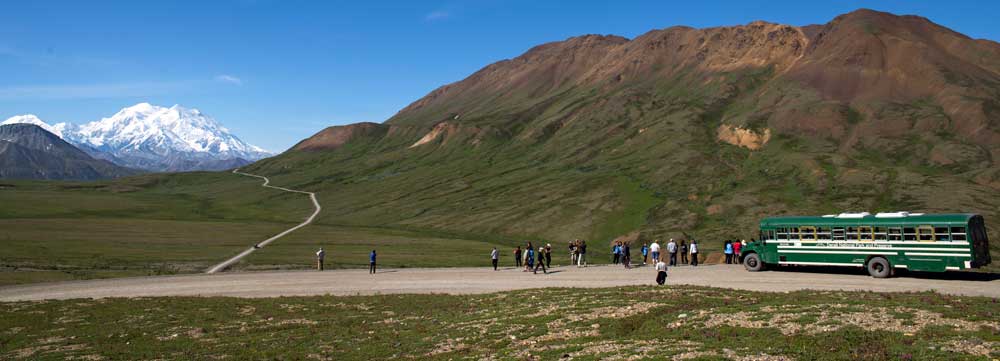
I didn’t have to wait very long before one of the park buses came by, heading back to the park entrance. Three and a half hours later I was back in my car and heading back to Fairbanks.
Now I might have ended the grizzly bear story right there but there is a short sequel to the story. The following year, the fall of 1983, another school year about to start and another Labor Day weekend. I decided I should get back on the pony and go for another hike in Denali. I wasn’t going to let no grizzlies stop me from something I loved doing. I had to get back on the pony and ride!
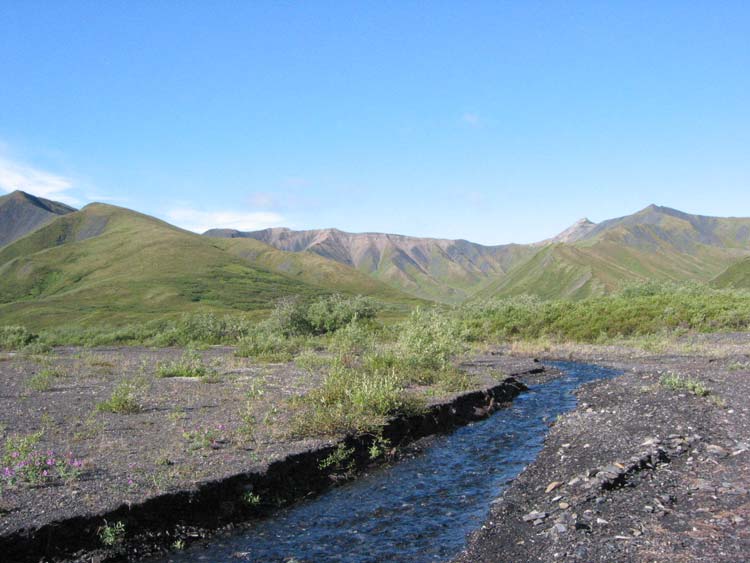
So I drove down from Fairbanks and went right to park headquarters to get an overnight permit. I had planned a nice easy hike along Jenny Creek (Hike 6) pretty close to the entrance to the park.
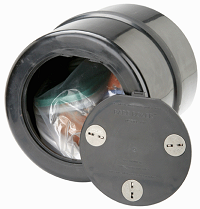
Again the ranger told me that’s a nice hike. Oh, but you should know, there have been some bear sitings in the area. Oh, and would you be willing to try one of these bear-proof containers we have to store food in. This container was a black cylinder about nine inches in diameter and fifteen inches long with a lid that could be locked in a way that bears apparently couldn’t figure out how to open them. Apparently the rangers were trying to wean grizzlies from going after hiker’s backpacks. If everybody would simply put their food in these bear-proof containers then bears would eventually dissociate backpacks with food and leave the backpacks alone. At least that was the theory!

A bit taken aback by this information about grizzly bear sitings, I didn’t immediately ask the ranger for a hike where there were no grizzly bear sitings. Hell no. I was getting back on the pony and ride. Suck it up, Baird. And I dutifully agreed to be a guinea pig and took one of the bear-proof containers.
The next morning I packed my food in the bear-proof container and put it in my backpack, caught the park bus and headed out to Savage River Campground where the Jenny Creek trail started. When I got off the bus, I strapped on my backpack and started heading down the road to the trailhead. I didn’t get but fifty steps when, all of sudden, visions of grizzly bears started dancing in my head.
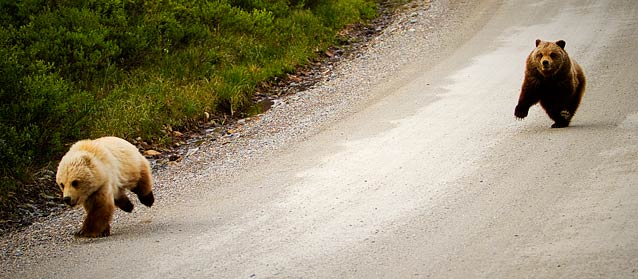
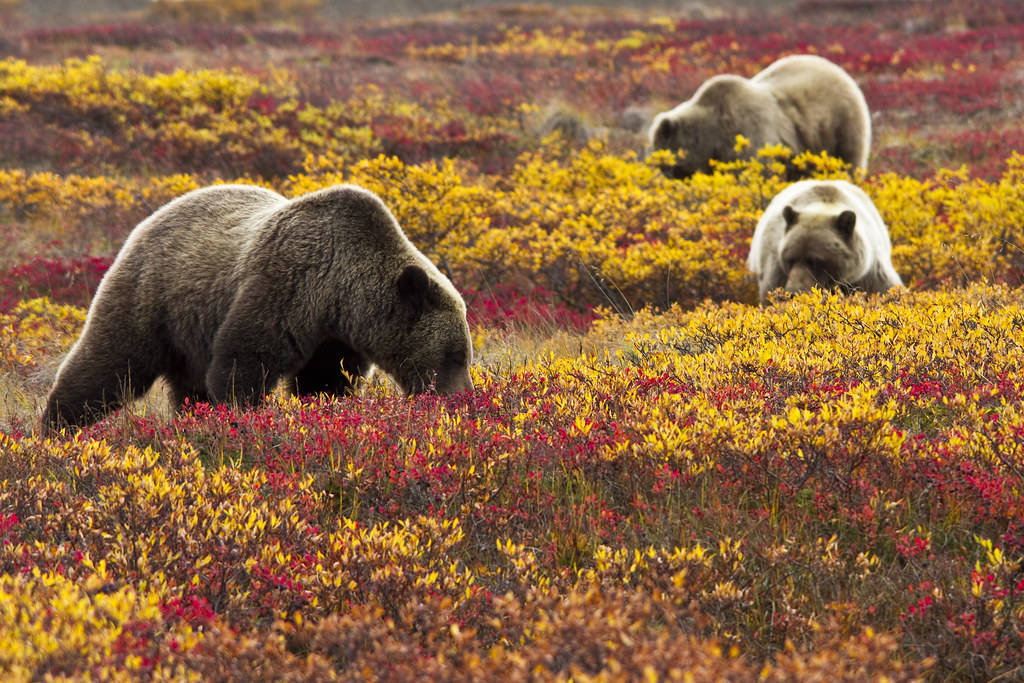
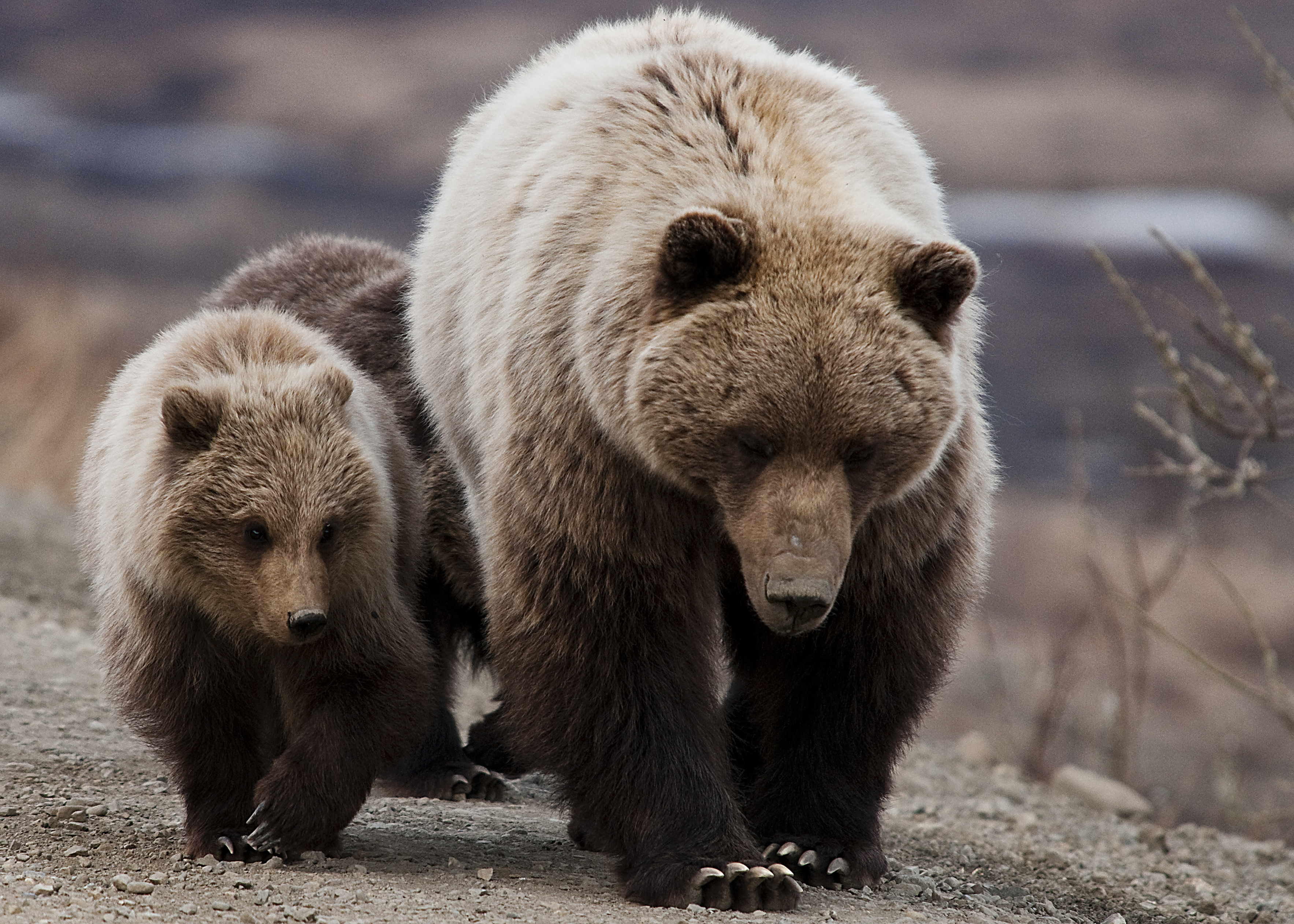
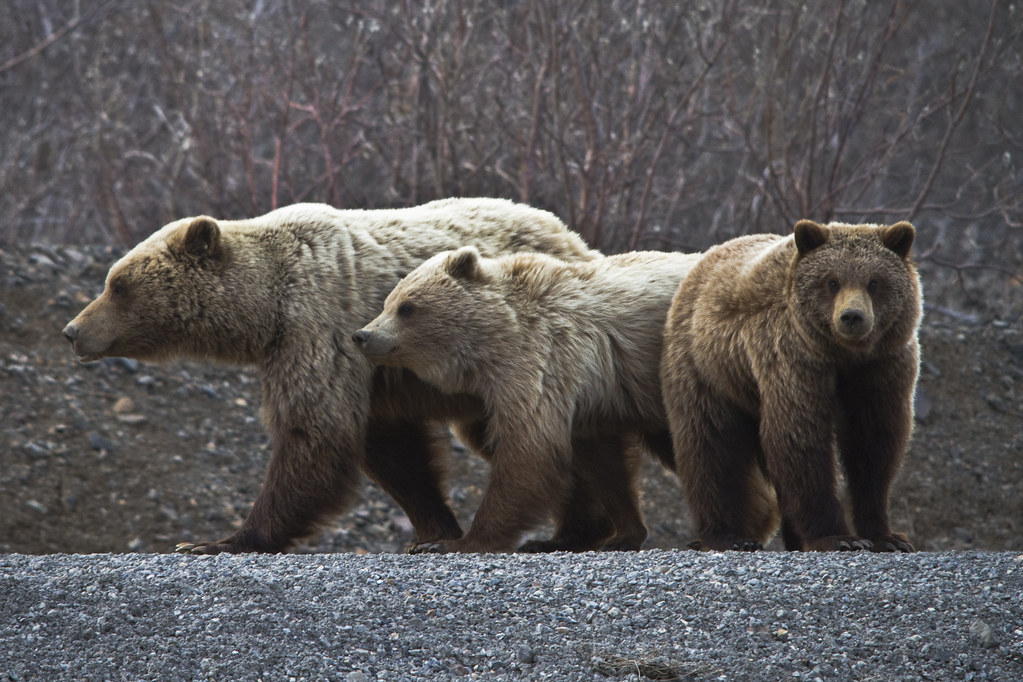
I asked myself why in the world did I want to go to an area where there had been grizzly bear sitings. I had to admit it I was afraid. I didn’t want to get back on the pony. I was finished with grizzly bears! So I turned around, got the next bus back to the entrance, returned the bear-proof container to the ranger with my apologies, got in my car, and headed back to Fairbanks.
I am, however, glad to say that that was not my last visit to Denali. I did go several times after that, but every time thereafter I went with friends! And I didn’t go into any area where there had been bear sitings! And two of those times I went with a friend on winter cross-country ski trips into the park – at a time when the grizzlies are hibernating!
As an addendum to this story, on Friday, August 24, 2012, almost thirty years to the day after I had my grizzly bear scare, 49-year-old Richard White, of San Diego, California, was mauled to death by a large male grizzly bear in Denali National Park.

Before the attack, White, who was hiking by himself, was taking photographs of the bear for at least eight minutes from a distance of 50 to 100 yards, much closer than the quarter-mile of separation (440 yards) that park rules now require.

The photographs from the recovered camera show the bear was grazing and not acting aggressively at all. Indeed the bear did not even seem to be aware of White until the last few photographs when the bear started staring at him. The following day an Alaska state trooper shot and killed the bear and recovered what was left of White’s remains. According to park officials, the attack was the first known fatal bear attack in the near century-long history of the park. For articles on this tragic tale, see
http://www.cbsnews.com/news/grizzly-bear-kills-hiker-in-denali-national-park/
Hearing that only one person had been killed by a grizzly in Denali Park in some ways makes me feel that I was not in as much danger as I thought. But learning of White’s death in circumstances that were somewhat similar to mine – hiking by myself, getting too close, not giving any warning – suggests that I was just lucky.
Others have lived to tell the tale of grizzly bear attacks and their stories are perhaps even a more powerful warning.